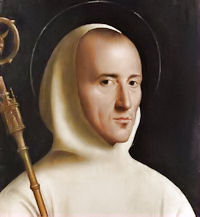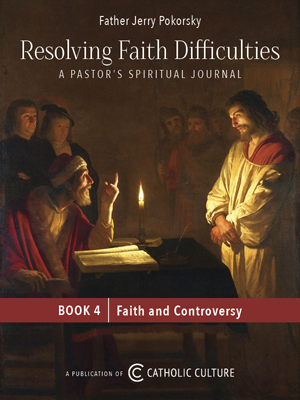Lent: April 1st
Thursday of the Fifth Week of Lent
Other Commemorations: St. Hugh of Grenoble, Bishop (RM)
» Enjoy our Liturgical Seasons series of e-books!
"Jesus said to the Jews: 'I tell you most solemnly, whoever keeps my word will never see death." (John 8:51) Christ brings us truth, He is the Truth itself, truth full of sweetness showing us the munificence of our Heavenly Father; from the bosom of the Father where He ever dwells, Christ reveals to us the Divine secrets which we possess by faith. What a feast, what satisfaction, what joy for the faithful soul to contemplate God, the Infinite and ineffable Being, in the Person of Christ Jesus; to hear God speaking in the words of Jesus; to discover what are God's sentiments, if I may thus speak, in the sentiments of the Heart of Jesus; to contemplate the Divine actions, to penetrate into their mystery, in order to drink there from, as at the source, the very life of God: Ut impleamini in omnem plenitudinem Dei! (Christ in His Mysteries, Dom Columba Marmion)
The Station in Rome is in the church of St. Apollinaris, who was a disciple of St. Peter, and afterwards bishop of Ravenna. He was martyred.
St. Hugh of Grenoble (or Châteauneuf)
In the eleventh century the diocese of Grenoble in southeastern France was notorious for corruption. Simony (the buying and selling of spiritual goods), usury, immorality, and ignorance were rampant in that area. During a Church synod at Avignon in 1080, it was decided that a strict bishop should be appointed to correct these abuses; one who could lead both clergy and laity to conform to the laws of the Church. Saint Hugh was unanimously elected to the office.
Hugh was born near Valence in southern France in 1053. After completing his formal education, he accepted a canonry (an official membership in the bishop's council) in the cathedral of that city. In his early twenties, he met the bishop of Die, who was impressed by Hugh's virtue and administrative talents and offered him a position in his own diocese. Hugh accepted the offer and later went with the bishop to the synod at Avignon, where he was unexpectedly elected to the see of Grenoble. After being ordained at the age of twenty-seven, he was consecrated bishop by the pope.
For two years, Hugh preached, fasted, and prayed in an effort to correct the many abuses in his diocese. Then, feeling that a new bishop might be more successful, he resigned and entered the novitiate at the Benedictine abbey of Chaise-Dieu. He was there only a short time when Pope Gregory VII commanded him to return to his see. Once again in Grenoble, Hugh more effectively fought the evils in his diocese. The poor were his greatest concern; once, during a time of famine, he sold his ornate gold chalice to buy them food. In 1084, when Saint Bruno, founder of the Carthusian Order, was looking for a site for a new monastery, Hugh, guided by a dream, granted him the territory known as "the Chartreuse" which gave the order its name. Hugh is often portrayed in art in connection with the Carthusians; he admired the monks and frequently visited them, happily joining in their exercises and performing the most menial tasks.
Throughout his fifty-two years as bishop of Grenoble, Hugh harbored a desire for contemplative life, but because of the tremendous influence of his holiness, pope after pope refused to release him from office. He died after a long illness and was canonized two years later by Pope Innocent II.
—The Lives of the Saints for every day of the year, Vol. 1: January-April
Patronage: against headaches; Grenoble, France
Symbols and Representation: carrying a lantern; one of a group of seven stars, representing the founders of the Carthusians; with Saint Bruno; with three flowers in his hand
Highlights and Things to Do:
- Read more about St. Hugh:
- In 1084 St. Hugh gave to St. Bruno and his six companions the land of La Grande, a desert in his diocese, called the Chartreuse, where they could live in solitude. It was here that St. Bruno founded the Carthusians. The entire name of the Carthusians is "Order of the Chartreuse." The liqueur Chartreuse originates from the Carthusians. Find out the history.
- Find out more about Carthusian monks and see the list of monasteries in the world.






